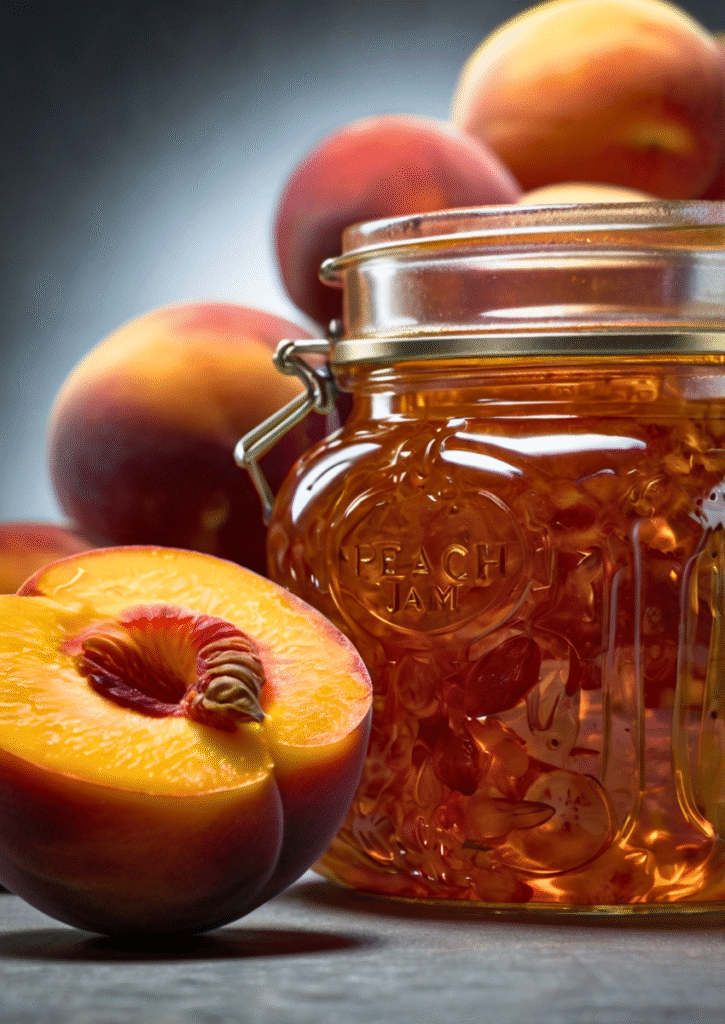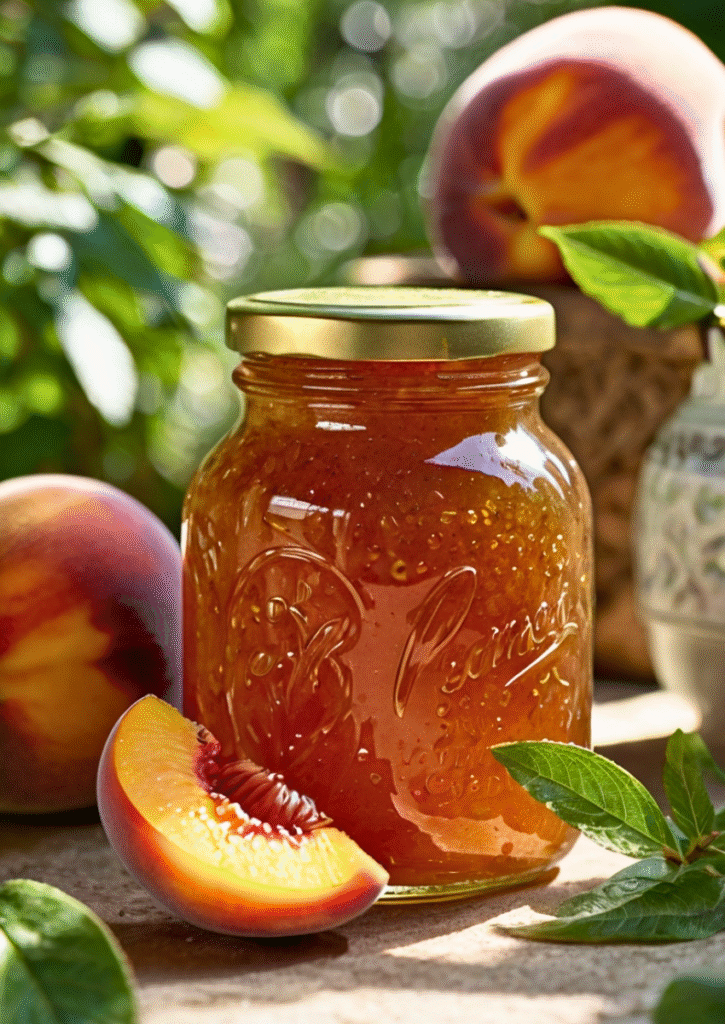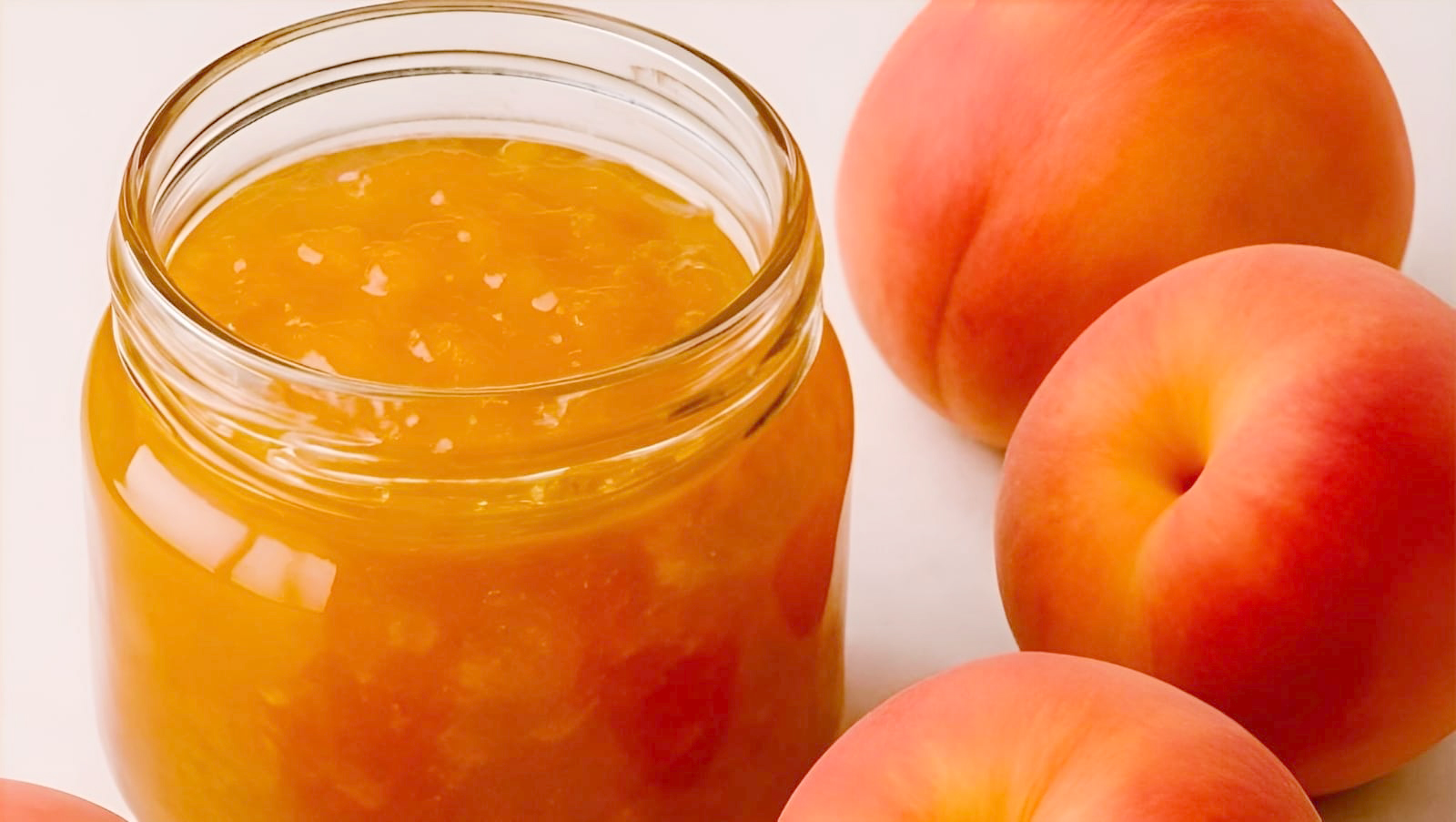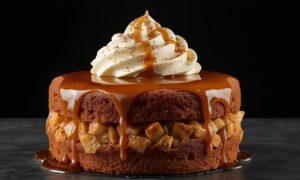Can you bottle the taste of summer? With Peach Jam, yes you absolutely can. Think of the soft warmth of sunshine, the scent of blooming trees, and the first bite of a perfectly ripe peach. Sweet, juicy, golden. That’s what Peach Jam captures in every spoonful.
I still remember standing in my grandmother’s kitchen on a late July afternoon. The windows were open. The scent of simmering peaches floated through the air. She worked with care no shortcuts, no fancy gadgets. Just a big pot, a wooden spoon, and baskets of freshly picked peaches. That day, I learned something timeless: real flavor comes from real ingredients and a little love. That memory became my first lesson in preserving food the old fashioned way.
This post is your step by step guide to creating homemade Peach Jam that’s bursting with flavor and free from preservatives. We’ll walk you through everything from choosing the right peaches to prepping them for that perfect balance of sweetness and texture. You’ll learn how to achieve the perfect consistency, how to avoid common mistakes like overcooking or under setting, and how to test your jam without any guesswork.
Don’t worry if you’re new to jam making. This recipe is beginner friendly and doesn’t require any special equipment. Just a pot, some patience, and a love for natural sweetness. If you’ve made jam before, you’ll find some fresh tips here to take your method to the next level. Want a chunky jam with peach bits? Or a smooth, spreadable version? We’ve got options.
You’ll also discover the many ways to enjoy your homemade Peach Jam on warm toast, in desserts, stirred into yogurt, or even paired with cheese boards. It also makes the perfect homemade gift. Tie a ribbon around the jar, and you’ve got a thoughtful treat straight from your kitchen.
By the end of this post, you’ll not only have a delicious jar of Peach Jam you’ll have a recipe to pass down, a new kitchen skill, and a reason to celebrate the simple joy of homemade preserves. Let’s get started and turn fresh peaches into a golden jar of sunshine.
Peach Jam Ingredients & Substitutions
Fresh Peaches (3 pounds, about 8-10 medium fruits) Choose freestone varieties like Elberta or Red Haven for easier pit removal. Fruit should yield slightly to gentle pressure but still feel firm. Avoid overly soft peaches that’ll break down too quickly during cooking.
Granulated Sugar (2 cups) White sugar enhances peach flavor without masking delicate notes. Brown sugar adds molasses undertones but can muddy the bright fruit taste. For reduced sugar versions, use sugar substitutes designed for canning, though texture may vary slightly.
Fresh Lemon Juice (1/4 cup) Citric acid prevents oxidation and boosts natural pectin levels. Fresh juice works better than bottled versions due to higher acid content. Lime juice substitutes well but changes flavor profile significantly.
Powdered Pectin (1 package, 1.75 oz) Optional Commercial pectin ensures consistent gelling, especially useful for beginners. Natural pectin from apple peels or lemon seeds creates more rustic texture. Skip entirely for soft set jam that’s perfect for yogurt or ice cream.
Vanilla Extract (1 teaspoon), Optional Enhancement Pure vanilla complements peach’s natural sweetness. Almond extract offers interesting variation but use sparingly just 1/4 teaspoon. Bourbon adds sophisticated depth for adult versions.
Professional tip: weigh ingredients rather than measuring by volume for consistent results. Sugar ratios affect both flavor and preservation qualities, so precision matters when batch making for storage.
Step by Step Instructions to Prepare Homemade Peach Jam

Prepare Your Workspace Set up a proper canning station with sterilized jars, lids, and a large water bath canner. Clean work surfaces prevent contamination that could spoil your finished product. Have a candy thermometer ready jam temperature indicates doneness better than visual cues alone.
Blanch and Peel Peaches Bring a large pot of water to rolling boil. Score an X on each peach’s bottom, then plunge into boiling water for 60-90 seconds. Transfer immediately to ice water bath. Skins should slip off easily when rubbed gently.
This technique prevents tough skin pieces in finished jam while preserving fruit integrity. Skip peeling if you prefer rustic texture, though some people find skin bits unappetizing.
Prepare the Fruit Remove pits and chop peaches into uniform pieces roughly 1/2 inch chunks work well. Smaller pieces cook faster but may turn mushy. Larger chunks maintain texture but require longer cooking times.
Toss chopped fruit with lemon juice immediately to prevent browning. This step also begins breaking down cell walls, releasing natural juices that form jam’s liquid base.
Cook the Jam Combine peaches, sugar, and lemon juice in heavy bottomed pot. Let mixture sit 10-15 minutes until sugar begins dissolving and fruit releases juices. This maceration step develops better flavor than rushing straight to heat.
Bring mixture to gentle boil over medium high heat, stirring frequently to prevent sticking. Reduce heat to maintain steady simmer once bubbling begins. Skim foam regularly it contains impurities that cloud finished jam.
Test for Doneness Jam reaches proper consistency when temperature hits 220°F (8 degrees above water’s boiling point at sea level). Alternatively, use the cold plate test: drop small amount onto chilled plate and push with finger. If it wrinkles and holds its shape, jam’s ready.
Cooking time varies from 15-45 minutes depending on fruit moisture content and desired thickness. Don’t rush this stage underdone jam won’t set properly while overdone jam becomes tough and candy like.
Final Assembly Remove from heat and stir in vanilla if using. Ladle hot jam into sterilized jars, leaving 1/4-inch headspace. Wipe rim clean, apply lids, and process in boiling water bath for 10 minutes.
Proper canning technique ensures shelf stable storage for up to two years. Improperly processed jam must be refrigerated and used within three weeks.
Peach Jam Cooking Techniques & Science
The science behind perfect peach jam involves understanding pectin behavior and sugar chemistry. Pectin naturally occurring in fruit cell walls forms gel networks when heated with sugar and acid. Peaches contain moderate pectin levels, requiring careful balance to achieve proper set.
Sugar serves multiple functions beyond sweetness. It draws moisture from fruit through osmosis, concentrating flavors while creating hostile environment for spoilage bacteria. The Maillard reaction between sugars and amino acids develops complex flavors during cooking, explaining why slow simmered jams taste richer than quick versions.
Temperature control prevents caramelization that turns jam brown and bitter. Professional preservers maintain gentle simmer rather than rolling boil, allowing moisture evaporation without burning sugars. Heavy bottomed pots distribute heat evenly, preventing hot spots that cause sticking and scorching.
Acid levels affect both flavor and safety. Lemon juice provides necessary acidity for proper gelling while creating environment hostile to botulism bacteria. pH below 4.6 ensures safe preservation when combined with proper canning techniques.
Copper pots, traditional in French jam making, conduct heat efficiently and react with natural fruit acids to enhance set. Stainless steel works equally well for home cooks, while aluminum may cause metallic off flavors with acidic ingredients.
Serving & Pairing Suggestions

Classic Applications Spread generously on warm buttermilk biscuits or English muffins for breakfast perfection. Layer between cake layers with cream cheese frosting for elegant desserts. Swirl into plain yogurt or oatmeal for healthy breakfast enhancement.
Gourmet Presentations Glaze roasted pork tenderloin or grilled chicken with warmed jam mixed with soy sauce and ginger. Create sophisticated cheese boards pairing peach jam with aged cheddar, brie, or goat cheese. Drizzle over vanilla ice cream with toasted almonds for restaurant quality dessert.
Beverage Pairings Mix jam with sparkling water for homemade sodas. Stir into hot tea for fruity sweetener. Create cocktail syrups by thinning with bourbon or brandy for adult beverages.
Professional chefs use peach jam as secret ingredient in barbecue sauces, adding fruity sweetness that balances smoky heat. The natural acidity cuts through rich meats while sugar aids in caramelization during grilling.
Seasonal Variations Summer pairs perfectly with fresh stone fruits serve alongside grilled peaches and burrata. Fall combinations include warm spices like cinnamon or cardamom mixed into jam before final cooking. Winter comfort foods benefit from jam’s bright flavors cutting through heavy dishes.
Final Thoughts on Peach Jam
Mastering peach jam requires patience, quality ingredients, and respect for traditional techniques that have preserved summer’s bounty for generations. This golden preserve captures not just fruit’s sweetness but entire season’s warmth in every spoonful. Whether spread on morning toast or incorporated into sophisticated desserts, properly made peach jam delivers complex flavors that commercial versions simply cannot match.
The key lies in selecting perfect fruit, maintaining proper cooking temperatures, and understanding pectin science that transforms simple ingredients into spreadable gold. Common mistakes rushing the cooking process, using overripe fruit, or skipping acid additions result in runny or tough textures that disappoint even forgiving palates.
Remember that jam making is both art and science. While recipes provide guidance, experienced preservers develop intuition for recognizing doneness through sight, sound, and aroma. The gentle bubbling of properly simmered jam, the way wooden spoon trails through thickened mixture, and that unmistakable peachy perfume all signal success.
Store your finished peach jam in cool, dark places where it’ll maintain quality for years. Each jar represents captured summer sunshine, ready to brighten winter mornings or enhance special occasion desserts. Master this fundamental preserve, and you’ll understand why generations of cooks have cherished the ritual of transforming fresh fruit into lasting treasure.
Frequently Asked Questions About PEACH JAM
Q: How do I fix runny peach jam that won’t set?
A: Runny jam usually results from insufficient pectin, acid, or cooking time. Return jam to pot, add 1 tablespoon lemon juice per cup of jam, and cook until proper temperature (220°F). Alternatively, add commercial pectin following package directions for remake batches.
Q: Can I reduce sugar in peach jam recipes?
A: Sugar serves preservation and gelling functions beyond sweetness. Reduce by maximum 25% without affecting safety or texture significantly. Use low sugar pectin for greater reductions, though shelf life decreases and refrigeration becomes necessary.
Q: Why does my peach jam turn brown during cooking?
A: Browning indicates excessive heat causing caramelization or Maillard reactions. Maintain gentle simmer rather than rolling boil. Add lemon juice at beginning to prevent oxidation. Use heavy bottomed pot for even heat distribution.
Q: How long does homemade peach jam last?
A: Properly canned jam lasts 1-2 years in cool, dark storage. Refrigerate after opening and use within 3 weeks. Signs of spoilage include mold growth, off odors, or unusual texture changes. Never taste suspicious preserves.
Q: What’s the best peach variety for jam making?
A: Freestone varieties like Elberta, Red Haven, or Georgia Belle work best due to easy pit removal and balanced sugar acid ratios. Slightly underripe fruit contains more natural pectin than fully ripe specimens. Avoid clingstone peaches that are difficult to process efficiently

Swiftly Captions by Tina Smith — Quick, flavorful food recipes made simple, bringing fresh inspiration to your kitchen every day






